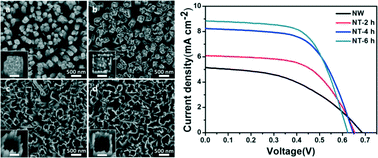Facile conversion of rutile titanium dioxide nanowires to nanotubes for enhancing the performance of dye-sensitized solar cells
Abstract
It has been proven that growing longer nanowires (NWs) with larger surface areas is not always a feasible way to increase the conversion efficiency of dye-sensitized solar cells (DSSCs) because the photogenerated electrons and holes may have higher recombination rates as the electron travel distance increases. In this work, we employed a convenient hydrothermal selective etching method to convert single-crystalline rutile TiO2 NW arrays to nanotube (NT) arrays. The resulting NTs retain many characteristics of the initial unetched NWs, such as the orientation, crystal structure, and geometry size (in terms of length and outer diameter). When used as photoanode materials in DSSCs, the as-prepared TiO2 NTs have achieved 112.5% enhancement in the overall power conversion efficiency compared to the initial unetched NWs. The significantly improved performance is credited to 1) the newly created inner surfaces, 2) the increased surface roughness, and 3) the unchanged electron travel distance. Our findings shed light on a new, general way to enhance the performance of the current NW-based DSSCs by simply converting initial NWs to NTs.


 Please wait while we load your content...
Please wait while we load your content...